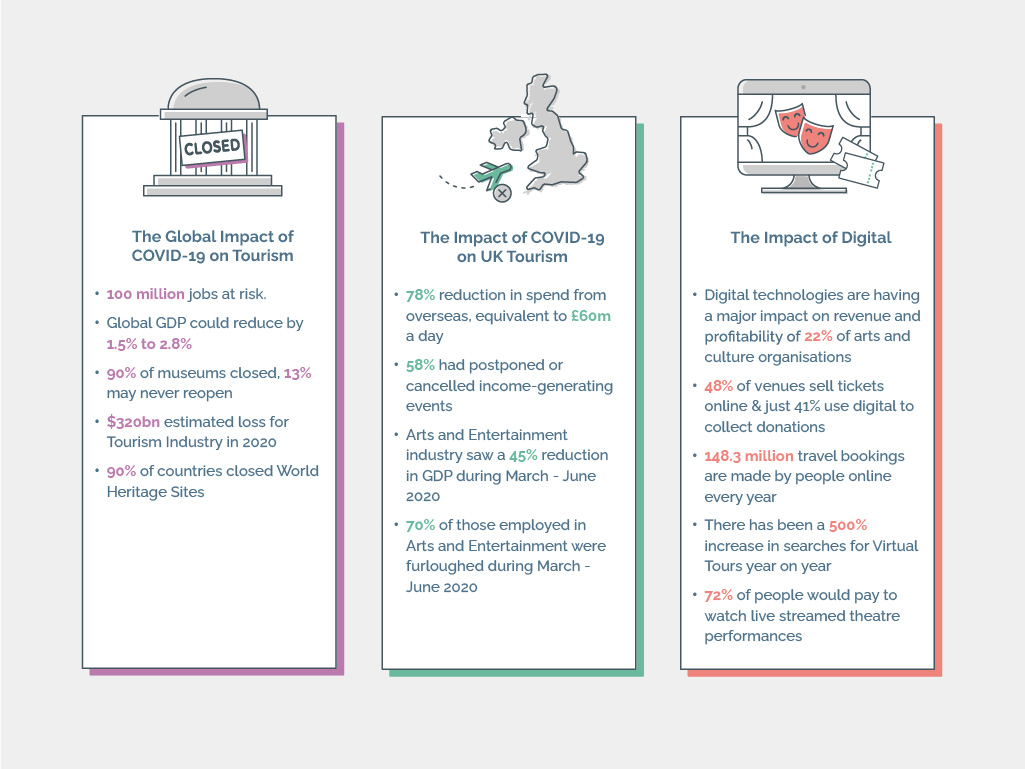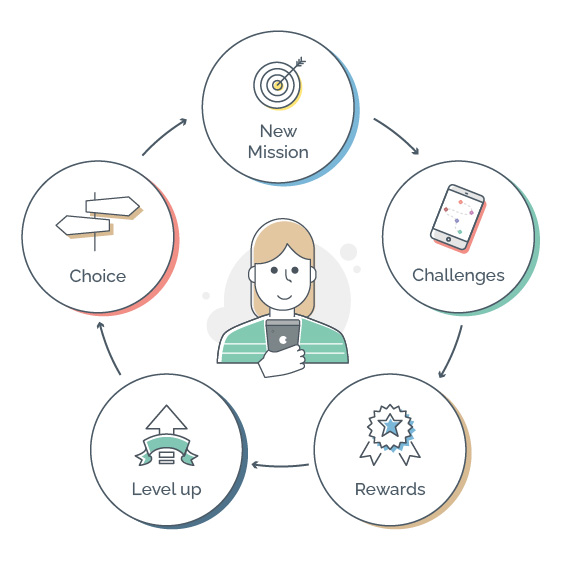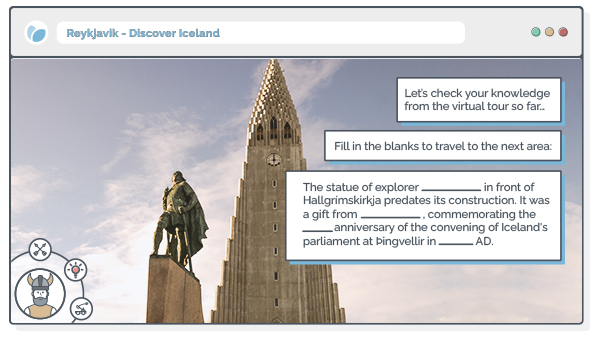At a time when people have not been able to get out and about with much ease, locations, venues, destinations and organisations dependent on attracting visitors have understandably suffered. Of all the sectors profoundly affected in the last year by the COVID-19 crisis, the hospitality, tourism and culture sector has potentially felt the sting the most.
On a global scale, tourism is the third-largest export category (after fuels and chemicals) and in 2019 accounted for 7% of global trade. Taken from the UNWTO Secretary General’s brief of the unprecedented economic impact of COVID-19, as many as 100 million direct tourism jobs are at risk, including associated industries such as accommodation and food services that provide employment for 144 million workers worldwide. Small businesses (which shoulder 80% of global tourism) are particularly vulnerable.
Within the UK, a Historic England survey on the effects of COVID-19 on the sector, 76% of respondents reported lost business in the short term and 58% had postponed or cancelled income-generating events due to the Coronavirus pandemic. Meanwhile in the three months leading up to June 2020, the arts and entertainment industry saw a nearly 45% reduction in GDP, leading to nearly 70% of workers being furloughed.
Facing the stark impact, the immediate priority is to boost competitiveness and build resilience. In order to strengthen and begin to recover momentum, many groups and organisations will be looking at economic diversification and promotion of domestic and regional tourism where possible. Experts believe this will need to involve advancing innovation and digital transformation, including investment in digital skills and exploration of digital solutions to preserve and promote work and experiences across industries, as well as a means of adapting to what could be a slow return to previous activity.
The question is not just how to reopen. As governments contemplate phased approaches, for some opening as before may not be possible or may not provide the much-needed injection of activity and revenue for a fast recovery. We will most likely be looking at slow progress to avoid the problematic booms that provoke subsequent restrictions. Consequently, many will need to consider alternative experiences or services to bolster their offering, different ways to carefully reconnect with communities, supporters and members, and either reassuring outreach or vastly innovative engagement to attract and appeal to a wide range of attitudes and emotions. Or even a combination of all of the above.
The challenge that continues to weigh on most minds is when people cannot physically come to you, how do you – as a site or destination or city – bring your offering to them? In a hugely competitive market, the pressure is on to do something amazing and do it right, or else face abandonment or rejection. How can you provide valuable, meaningful but exciting experiences that people may be willing to pay for or donate towards as a way to stay afloat, nurture advocacy, and attract participation? The answer may require some strategizing, but by applying imagination and innovation, the results could outlast the current crisis and even provide some futureproofing for a sector already rich in inspiration and attraction.

Experiences and Engagement
Let us perhaps start with an easier set of questions: how can we easily reach large audiences? How can we make sure what we create is easily adaptable and even repeatable? The answer is probably already at your fingertips right now. Technology is more powerful, flexible and accessible than ever before, with improvements and new devices and platforms arriving every day. There are more ways to get closer to end users or consumers. More insight into needs and expectations, more possibilities to translate experiences to screens – either wide or palm-sized. And audiences are more than ready to try new ideas. In the UK Gov Digital is Future 2018 survey, 30.6% of adults had participated in some form of digital culture (defined as visiting websites or apps). 60% of consumers reported that they believed experientialism (the use of large-scale projections, holograms, virtual reality or augmented reality) had already become the future of events. Epson’s research “The Experiential Future”, points to how immersive and experiential elements could be the future of retail outlets and the high street with 67% of Millennials more likely to shop in-store if there was an experiential element included, followed by 65% of Generation Z, 58% of Generation X and 52% of Baby Boomers.
These shifts in attitude demonstrate that more audiences are coming to expect technology as a primary vehicle for connecting, promoting, communicating. The next important step is in mastering how to make those digital experiences last longer than a few ephemeral seconds, designing instead to hook consumers, captivate hearts and minds, and nurture lasting, emotional connections through a variety of methods.
When looking to apply this across tourism, hospitality or culture, we need to take into account the expectations of today’s tourists or consumers. In the current situation many organisations find themselves in, the objective is to reignite sparks across different audience groups to get people excited, engaged and feel encouraged, to help kick-start the sector again. How can you influence attitudes to make people who were hoping for a holiday abroad feel equally excited about a staycation? How can you communicate information to reassure around safety measures? What extra incentives are dotted across your offering to draw people back? Or how do you provide a great experience to someone who is not yet comfortable with or able to leave their home or area?
Tourism, or tourism-adjacent products and services are already experiential by nature. The essence of tourism is the development and delivery of experiences to people who wish to see, understand, and experience different destinations or the way people live, work, and enjoy life in those destinations (Ritchie, Tung, & Ritchie, 2011). Given the evaluative and recommendation-based aspects to the sector, tourism organisations (hotels, airlines, booking platforms, destinations, etc) began extensively implementing Customer Engagement strategies in one form or another long before COVID-19, to engage with their customers at various stages of ‘consumption’ (pre, during, post). By looking at it through a Customer Engagement lens, organisations are able to extend the visitor experience beyond the service or visit to provide multiple opportunities to have a positive and meaningful influence on consumer attitudes and behaviour, and create a lasting connection. The same way retail brands look to increase footfall, advocacy, loyalty, and revenue through carefully curated Customer Engagement and Experience strategies, similar principles can work or at least be adapted across tourism. Whether you’re browsing for a new pair of trainers or looking for something different to do this weekend, as a consumer you will naturally turn to your preferred device and surf for the winning product or service that speaks to you – that helps you picture yourself enjoying the end result, that stands for similar values, that provides a seamless browsing experience, that sends relevant, personalised communications when you exchange information, that gives you that value-add feeling. Developing experiences to attract the Digital Tourist, the focus should be the same – considering the end users’ needs or expectations and designing them into the heart of whatever experience or offering you create.
For digital solutions, from virtual reality to 360-degree photographic tours, there are a wealth of options available to the likes of museums, libraries and tourist attractions. However, is recreating the visual in the virtual enough? When you visit a museum, it is a visceral experience, with all of your senses being treated to sights, sounds and smells. You can touch objects, interact with exhibits, listen to the stories behind them and more.
Poorly implemented or irrelevant technology could make all that magic fall flat. However, interweaving an intuitive and attractive design, and integrated, rich user-centric strategy to capture hearts and minds of all backgrounds and interests, different digital functionalities and solutions can help people truly live the experience – and even relive it time and time again.
While you may not be able to touch the skin of a dinosaur via your phone at home, but you can see it come to life and roam through prehistoric jungles. You can listen to a narrator explain to you how they lived, whilst watching them hunt. You can take control of them and explore on your own, discovering new facts as you go. The experience is translated and enhanced, becoming richer and more meaningful than just a marketing tool to raise your profile.
So, what can you weave into the story you want to tell?

Narratives, Story Telling and Game Design
Designing experiences that focus on strong storytelling can take your users on a journey that is engaging, entertaining and educational. They are elements that allow people to fully immerse themselves in a situation and detach themselves from the daily routines, distractions or even restrictions in their own real world. As a design feature, they really help participants get the most out of both the experience and are a proven method to help improve learning and wider engagement.
Within arts, culture, heritage, tourism and hospitality, storytelling becomes a match made in heaven given there is ample material or existing characters to seek inspiration from. Narratives encourage exploration in both virtual and real spaces; for example, creating intrigue to draw people to different areas of a city, or enticing them off the beaten track to hidden gems. There are even ways to make the participants the protagonists by providing tools to create their own stories, such as sharing their adventures with others on micro-blogging sites like Medium and Instagram, helping to promote and advocate for the experience.
Though story-telling and narratives lend themselves well to the sector, there are many elements of game design that can be woven into creating exciting and engaging experiences. Setting missions that require users to visit (physically or remotely) locations to move the narrative on or earn some kind of reward can drive users to visit new and unexplored places. Providing opportunities to win prizes can keep users coming back. Adding “multiplayer” like social elements, such as group tasks, can create a sense of community allowing them to share their experiences and help each other, without necessarily being physically near each other.
Picture inviting visitors for weekend missions where by downloading an app, they have the chance to immerse themselves in the life of a well known author, setting them missions or challenges that take them around their birthplace, encouraging collaboration and friendly competition, blending quizzes based on their well-known tales with facts from their own life story – and blending local businesses and destinations with the participant’s journey. Visitors leave with more knowledge and appreciation for the area, and the sense of having done much more than just sightseeing.
Immersive Exploration & Virtual Reality
In some ways the pandemic propelled interest in VR and gave it a chance to shake off perceptions of it just being a passing fad or gimmick. Trapped in the four walls of our homes, Virtual Reality is one of the truest definitions of escapism and as it becomes more accessible, the potential continues to grow. There are games to give you a cardio rush, traditional games that engage you in missions and quests, but there are a growing number of experiences that utilise the medium as a way to blend learning, exploration and immersion with more emphasis on ‘reality’. And many feel it is here that the concept of a digital (or virtual) tourist has the potential to flourish into something exciting.
Various destinations have started showcasing locations and attractions through VR in recent years to diversify their marketing approaches. Groups such as the German National Tourist Board adopted VR as a marketing tool, raising the profile of its attractions and piquing interest as they take Oculus Rift viewers on 360º video tours across the country. It is arguably a more competitive approach to garnering interest, but the impact VR can have as a marketing tool that converts fun videos into ROI is still yet to be seen. What is evident is the demand that exists, combined with people’s need to explore – albeit virtually for now. Searches related to “virtual tours” have grown globally by over 500% year over year suggesting people may even prefer alternatives to in-person tours until they feel safe or ready again.
The benefit of developing technological solutions such as VR is that, if done well to ensure adoption and usage, they can be a cost-effective and powerful way to help clients feel more comfortable and more willing to travel. From a practical point of view, VR can be highly effective for learning settings. For cities, airlines and airports, hotels, or larger organisations looking to incentivise travellers, VR experiences can help set expectations and improve understanding before they go to book anything, for instance explaining to users what health and safety measures are now in place to keep them comfortable. For specific destinations, such as museums or similar tourist attractions, VR could bring an experience to life for people not yet ready to leave the comfort of home but who are missing that sense of adventure or discovery. Virtual Reality as a design mechanic has great potential, but on its own all you are really showing is an immersive video experience. By adding motivational and behavioural design to it, you can create something that truly hooks the imagination and interest of participants.
Imagine visiting a virtual library, where you can not only read the books on the shelves, but you can hear from their authors, learn how the book came to be, what got left out, what they might have changed.
You can take the design much further, by creating video or live-action role-play games that add to a visitor or users overall enjoyment of their experience. These could be stand-alone games designed to attract people or fully integrated to augment the existing physical or virtual experiences.
When you open the book in the libraries app, the characters could come to life – playing out the story in front of you and then offering you a chance to decide how the story branches. Do you follow the original narrative, or make changes and see how the ending is altered?
All of this is made possible with the use of the right technology and an understanding of where it is appropriate to use it. Not only does this open up attractions to wider audiences, for example bringing museums into classrooms around the world for interactive lessons, but it also creates an opportunity for augmented and enhanced physical experiences when visitors are once again allowed to come through the doors.

Personalisation and User Centricity
Finally, but possibly most importantly, personalisation. As we come out of various lockdowns and restrictions to our lives, something we will likely want more of is control of how we enjoy our new freedom. When this comes to what we are going to do with our spare time, it is an opportunity for attractions to provide something different and interesting for potential visitors and tourists, physical or virtual, by offering as much flexibility and personalisation of the experience as possible.
The development of apps that work as virtual tour guides, offering location-based tips on exciting sights to visit near them will give visitors the chance to start to build their own custom tours and outings. You can then allow users to choose the types of exhibits or attractions they are interested in and further personalise their experience by only suggesting things that fit those preferences.
Make it as easy as possible for people to find an experience that they may enjoy by offering related recommendations or creating easily navigable apps or websites that can take their preferences and offer focused suggestions. Even before the pandemic, up to 83% of customers felt that said they felt brands should offer them suggestions based on their personal preferences.
More than “A Day Out”
Post COVID-19, people will naturally want to get out more and travel again but may well be nervous of doing so. At the same time, those leading within the culture, tourism and hospitality sector will be determined to revive activity and re-establish some form of normality and security for thousands of organisations, destinations and venues. It will be a huge challenge, but simultaneously could be a grand opportunity for the industry to showcase just what they have on offer for a range of interests, needs and abilities.
In the UK alone, when asked what type of vacation they expect to take in the next 12 months 38% of respondents said they now expected to take a domestic vacation and 20% expected to take a staycation in their local area (Google Trends 2020). There have also been shifts in consumer demand around the specific location of domestic vacations. While demand for beach destinations has remained consistently high, in August this year, UK searches for ‘country holiday’ surpassed the term ‘city break’ for the first time in over 10 years. The desire and appetite for escapes, exploration and relaxation is undoubtedly there, but collectively we need to be ready to navigate and adapt to new expectations. Creating alterative, parallel, or more accessible experiences as part of a support network will be imperative to help the sector create momentum again in the long run. Designed with long lasting engagement in mind, they will also have the capacity to futureproof against any more bumps the road ahead brings. Designed with users in mind, you’re creating experiences that will be more diverse and inclusive and accessible than ever before.
The use of the right technology can support all stages of accessibility as we all initially emerge from lockdowns or get used to new circumstances and habits. Digital can play a powerful role in feeding the need for exploration, learning, inspiration, excitement, and can step in to fill in gaps across experiences, keep connections and channels open for broader communities, and can empower the brilliant teams behind some of our beloved destinations, projecting the stories they have to tell to all who are ready to listen.


